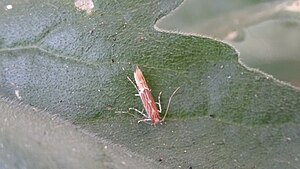Labdia semicoccinea
| Labdia semicoccinea | ||||||||||||
|---|---|---|---|---|---|---|---|---|---|---|---|---|

Labdia semicoccinea |
||||||||||||
| Systematics | ||||||||||||
|
||||||||||||
| Scientific name | ||||||||||||
| Labdia semicoccinea | ||||||||||||
| ( Stainton , 1859) |
Labdia semicoccinea is a butterfly ( moth ) from the family of cosmopterigidae (Cosmopterigidae).
features
The moths reach a wingspan of 11 to 14 millimeters. The head is beige-brown. The antennae are dark brown and have a white line dorsally . There are three white sections at the tip of the antenna. The thorax is orange-brown and has two gray longitudinal lines dorsolaterally . The tegulae are orange-brown and lined with gray inside. The forewings are orange-brown beyond the middle of the wing and ocher-yellow in the apical region. They are narrowly lined with light yellow on the Costa loader and on the inner edge of the wing. The wing drawing consists of a number of gray lines of different widths. The first borders on the ocher yellow Costa line. The second starts at the Costalader near the base of the wing and splits into two lines in the middle. The lower of the two lines runs along the anal fold. The third line starts at the base of the forewing and runs above the anal fold to the middle of the orange area. The fourth line is more brownish-gray and runs along the light yellow dorsal line, in the middle it branches off towards the middle of the wing. On the inside of the fourth gray line there is a light yellow spot halfway along. A narrow brown Costa line extends from 1/3 to 3/4 of the forewing length. It suddenly widens in the apical area and is interrupted by a gray-white line. At the end of the first gray line there is a blackish subcostal spot, which is lined with gray-white basal and distal edges. Opposite in the dorsal area is a gray wipe that runs diagonally inwards. A similar but more curved wipe is on the interior corner . This is bordered on the inside by a brownish-gray line that slopes outwards. The fringed scales are ocher yellow on the Costa loader, gray-brown on the apex and gray-brown near the inner corner. At the inner corner they have a broad, yellow ocher line. The hind wings are gray, tinged brown at the apex. The fringed scales are ocher gray. The abdomen is light gray, the 1st to 3rd segment is dorsal ocher. The males have light yellow tufts of fragrant hair on the metathorax, which arise directly below the hind wings. They curve inward over the abdomen and partially cover the first three segments.
In the males the right brachium is very long. It tapers distally and has a flattened, severely sclerotized apex. The left brachium is broad and forked and half as long as the right. The blades are lanceolate and taper to a point distally. They are narrowest in front of the middle. The left valvella is very long and narrow and slightly curved. The short aedeagus is located in a very slender, upwardly curved and apically hook-shaped anellar tube and is therefore not visible.
In the females the rear edge of the 7th sternite has a deep indentation. The ostium is narrow. The sterigma elongates into a long, heavily sclerotized tube. The ductus bursae is as long as the corpus bursae and very narrow. The corpus bursae is long and pear-shaped, there are no signs.
distribution
Labdia semicoccinea is native to Japan ( Honshū , Shikoku and Kyushu ), South Korea , the Orientalis and Australia . The species was probably introduced in Abkhazia ( Georgia ). In the Netherlands, the species was repeatedly found on imported plants and trees from Sri Lanka , Taiwan and Japan.
biology
The caterpillars feed on the stems of Cajanus indicus (Fabaceae) and various Polyscias species (Araliaceae). In the Netherlands, the caterpillars were also imported Palmfarnarten ( Zamia ) and Prunus donarium found and bred. In Georgia, the moths were caught in the light in July .
supporting documents
- ↑ a b c J. C. Koster, S. Yu. Sinev: Momphidae, Batrachedridae, Stathmopodidae, Agonoxenidae, Cosmopterigidae, Chrysopeleiidae . In: P. Huemer, O. Karsholt, L. Lyneborg (eds.): Microlepidoptera of Europe . 1st edition. tape 5 . Apollo Books, Stenstrup 2003, ISBN 87-88757-66-8 , pp. 122 (English).
- ↑ Labdia semicoccinea (Stainton, 1859) photos. www.jpmoths.org, accessed January 19, 2012 .